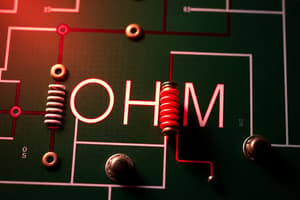Podcast
Questions and Answers
According to the electron theory, which direction does the current flow?
According to the electron theory, which direction does the current flow?
- From a point of high potential to a point of low potential
- From the negative terminal to the positive terminal (correct)
- From a point of low pressure to a point of high pressure
- From the positive terminal to the negative terminal
What is the unit for measuring the rate of transfer of charge?
What is the unit for measuring the rate of transfer of charge?
- Ampere
- Ohm
- Volt
- Coulomb per second (correct)
What is the abbreviation for ampere?
What is the abbreviation for ampere?
- A
- I
- Amp (correct)
- V
If 1 C flows through a circuit each second, what is the current?
If 1 C flows through a circuit each second, what is the current?
What does I = 3 A represent in relation to electric current?
What does I = 3 A represent in relation to electric current?
What did Edison discover when he connected the filament battery and allowed the filament to heat until it glowed?
What did Edison discover when he connected the filament battery and allowed the filament to heat until it glowed?
What was the direction of the electrical current flowing in the filament-plate circuit according to Edison's reasoning?
What was the direction of the electrical current flowing in the filament-plate circuit according to Edison's reasoning?
Why did Edison place a positive charge on the plate in the filament-plate circuit?
Why did Edison place a positive charge on the plate in the filament-plate circuit?
What is the actual application of a basic law mentioned in the text?
What is the actual application of a basic law mentioned in the text?
What was Edison's reaction to his discovery of electron flow across the space between filament and plate?
What was Edison's reaction to his discovery of electron flow across the space between filament and plate?
What is the main reason carbon is used in rubbing connections with commutators or slip rings?
What is the main reason carbon is used in rubbing connections with commutators or slip rings?
What is the overall charge of an atom that gains an electron?
What is the overall charge of an atom that gains an electron?
In a liquid, which type of atoms are ionized to form ions?
In a liquid, which type of atoms are ionized to form ions?
What direction do negatively charged ions move in a liquid?
What direction do negatively charged ions move in a liquid?
What is the main significance of carbon as a conductor compared to other non-metal solids?
What is the main significance of carbon as a conductor compared to other non-metal solids?
What is the relationship between voltage and potential difference?
What is the relationship between voltage and potential difference?
How does resistance affect the current in a circuit with steady EMF?
How does resistance affect the current in a circuit with steady EMF?
What is the unit of electrical resistance?
What is the unit of electrical resistance?
How does resistance change with the length of a conductor?
How does resistance change with the length of a conductor?
What happens to resistance when cross-sectional area of a conductor increases?
What happens to resistance when cross-sectional area of a conductor increases?
According to Ohm's law, what is the relationship between voltage, current, and resistance?
According to Ohm's law, what is the relationship between voltage, current, and resistance?
What factors control the resistance of an object like a wire conductor?
What factors control the resistance of an object like a wire conductor?
In which scenario does a material offer more resistance to the flow of electric current?
In which scenario does a material offer more resistance to the flow of electric current?
What is the reciprocal of resistance in an electric circuit?
What is the reciprocal of resistance in an electric circuit?
What happens when ions reach the electrodes in an electrolyte solution?
What happens when ions reach the electrodes in an electrolyte solution?
What causes gases to become conductors when ionized?
What causes gases to become conductors when ionized?
In which conditions does ionisation occur?
In which conditions does ionisation occur?
What did Thomas Edison discover in his quest to keep soot from clouding his incandescent light bulb?
What did Thomas Edison discover in his quest to keep soot from clouding his incandescent light bulb?
How does thermionic emission relate to incandescent light bulbs?
How does thermionic emission relate to incandescent light bulbs?
What type of compound is acetic acid based on its ability to conduct electricity?
What type of compound is acetic acid based on its ability to conduct electricity?
Which of the following best describes the molecular structure of compounds with strong conductivity?
Which of the following best describes the molecular structure of compounds with strong conductivity?
What type of materials are commonly used as conductors due to their single valence electron?
What type of materials are commonly used as conductors due to their single valence electron?
What happens to ions when they reach the electrodes in an electrolyte solution?
What happens to ions when they reach the electrodes in an electrolyte solution?
Which type of compound dissociates into positively charged sodium and negatively charged chlorine ions in water?
Which type of compound dissociates into positively charged sodium and negatively charged chlorine ions in water?
What is the main component of vinegar that is a poor conductor of electricity?
What is the main component of vinegar that is a poor conductor of electricity?
Which of the following compounds is an example of a weak electrolyte?
Which of the following compounds is an example of a weak electrolyte?
What determines the conductivity of compounds with strong conductivity?
What determines the conductivity of compounds with strong conductivity?
Insulators are characterized by atoms that have a single valence electron very loosely bound to the atom.
Insulators are characterized by atoms that have a single valence electron very loosely bound to the atom.
Gold is commonly used as a semiconductor due to its molecular structure.
Gold is commonly used as a semiconductor due to its molecular structure.
Flashcards are hidden until you start studying
Study Notes
Electric Current and Flow
- Electric current flows from negative to positive.
- The unit for measuring the rate of transfer of charge is Coulomb (C).
- The abbreviation for ampere is A.
- If 1 C flows through a circuit each second, the current is 1 A.
- I = 3 A represents a current of 3 amperes.
Edison's Discovery
- Edison discovered that when he connected the filament battery and allowed the filament to heat until it glowed, it produced a flow of electrons across the space between the filament and plate.
- According to Edison's reasoning, the electrical current flowed from the negative filament to the positive plate.
- Edison placed a positive charge on the plate to create a flow of electrons.
Electric Conduction
- Carbon is used in rubbing connections with commutators or slip rings due to its unique properties.
- When an atom gains an electron, it becomes negatively charged.
- In a liquid, atoms are ionized to form ions.
- Negatively charged ions move towards the positive electrode in a liquid.
- Carbon's conductivity is significant compared to other non-metal solids due to its unique properties.
Voltage and Resistance
- Voltage and potential difference are equivalent.
- Resistance affects the current in a circuit with steady EMF, reducing it.
- The unit of electrical resistance is Ohm (Ω).
- Resistance increases with the length of a conductor and decreases with the cross-sectional area of a conductor.
- Ohm's law states that voltage is equal to the product of current and resistance.
- Factors controlling the resistance of an object like a wire conductor include its length, cross-sectional area, and material properties.
Ionization and Conductivity
- When ions reach the electrodes in an electrolyte solution, they are neutralized.
- Gases become conductors when ionized.
- Ionization occurs under certain conditions, such as high temperatures.
- Thomas Edison discovered thermionic emission in his quest to keep soot from clouding his incandescent light bulb.
- Thermionic emission relates to incandescent light bulbs, where heat causes electrons to be emitted.
- Acetic acid is a poor conductor of electricity.
- Compounds with strong conductivity have a molecular structure that allows for easy movement of electrons.
- Materials with single valence electrons, such as copper, are commonly used as conductors.
- Ions are neutralized when they reach the electrodes in an electrolyte solution.
- Sodium chloride dissociates into positively charged sodium and negatively charged chlorine ions in water.
- The main component of vinegar that is a poor conductor of electricity is acetic acid.
- Vinegar is an example of a weak electrolyte.
- The conductivity of compounds with strong conductivity is determined by their molecular structure.
Insulators and Semiconductors
- Insulators are characterized by atoms that have a single valence electron very tightly bound to the atom.
- Gold is not commonly used as a semiconductor due to its molecular structure.
Studying That Suits You
Use AI to generate personalized quizzes and flashcards to suit your learning preferences.



